The MGH invite you to join us on a trip through 200 years of medieval research history: The series “Treasures of the MGH Library and Archive” presents a treasure trove of rare and fascinating items illustrating key moments of our history. Enjoy discovering!
Writing in 1820 as an honorary member of the newly formed „Gesellschaft für ältere deutsche Geschichtskunde“ – today known as the MGH -, the famous poet Johann Wolfgang von Goethe asked for an expert opinion on his reading and interpretation of the inscription engraved around the depiction of a baptism scene on the bottom of a precious silver baptismal bowl. Together with his request, he sent a drawing and description of the bowl, his transcription of the inscription, and some historical background information. At that time, the bowl was in the possession of Goethe’s patron, Grand-Duchess Maria Pavlovna of Weimar, and the poet hoped for scholarly assistence in his bid to please her. He closed his letter with polite wishes: „May this request be graciously received, just as I hope to recommend myself to the honourable association,“ little knowing what controversies would arise therefrom.
The association’s journal, the Archiv der Gesellschaft für Ältere Deutsche Geschichtkunde, became the forum for a heated discussion over the inscription. Later, Goethe noted that his request had „given rise to a highly entertaining debate; instead of providing us with concise knowledge of who was the godfather and who the godchild, the experts themselves are deeply divided and have already given us four or five different opinions on the matter.“
What were they arguing about? An example of the learned discussion are the following solutions for the abbreviation „DO“ in the outer inscription (on the upper left hand side beside the crucifix):
Goethe's transcription of the passage reads:
Cesar et Augustus haec Ottoni Fridericus
Munera patrino contulit ille donum
In 1821, Karl Geog Dümgé corrected this reading: „By the way, the word donum in the inscription must be read as dono“ (Über eine silberne Schale, S. 460). Georg Friedrich Grotefend initially agreed with this solution, but later changed his mind, suggesting the solution domo (ebd. S. 467).
In the next volume of the „Archiv“, 1822, Ludwig Moser commented on the passage „the last word, that was read there as donum, I would have read as Deo“ (Auch ein Wort, S. 272). Nevertheless, in the same issue Anton Christian Wedekind offered an interpretation of the inscription based on the reading of dono (Zur Erklärung, S. 275).
To our eyes, it seems strange that the journal’s editor in chief, Dümgé, actively commented on the discussion by adding numerous remarks, thus always reserving the final word for himself. Today, we would probably find him an unbearable know-it-all – one can only imagine how the authors found it 200 years ago! From the fifth volume onwards, Georg Heinrich Pertz took charge of editing the „Archiv“, giving the journal a rigorously methodical structure. Thenceforth, there was no room more for such open discussions about the baptismal bowl.
Godchild or godfather: who was what?
Today, the silver baptismal bowl is part of the collection of the Kunstgewerbemuseum in Berlin. On the online platform „Kunstindex des Deutschen Dokumentationszentrums für Kunstgeschichte“, the bowl is presented as „Taufschale von Friedrich Barbarossa mit Otto Graf von Cappenberg“ (baptismal bowl of Frederick Barbarossa with Otto Graf von Cappenberg).
There, the text of the inner inscription reads: QVEM LAVAT UNDA FORIS HOMINIS MEMOR INTERIORIS VT SIS Q(u)OD N(on) ES ABLVE T(er)GE Q(u)OD ES (You, whom the water cleans on the outside, be also mindful of your inner person! To become what you are now not, wash and clean that what you are!). The outer inscription (with our controversial word) is transcribed as: CESAR ET AVGVSTVS HEC OTTONI FRIDERICVS MVNERA PATRINO CONTVLIT ILLE DEO (Emperor Frederick gave this present to his godfather Otto; he in turn gave it to God).
A. Marquard-Mois
Dümgé, Karl Georg/ Grotefend, Georg Friedrich: Über eine silberne Schaale, welche von Ihrer Kaiserlichen Hoheit der Durchlauchtigsten Frau Erbgroßherzogin von Sachsen-Weimar aus der Sammlung des verstorbenen Chorherrn Pick zu Cölln erkauft, und den Weimarschen Sammlungen zugesellet worden, Mittheilung des Hrn. Geh. Raths von Goethe in Weimar, erläutert von C. G. Dr. Dümge und Professor Dr. Grotefend, in: Archiv der Gesellschaft für Ältere Deutsche Geschichtkunde 3 (1821), S. 454-469. (digizeitschriften.de)
Moser, Ludwig: Auch ein Wort über die silberne Schale zu Weimar, in: Archiv der Gesellschaft für Ältere Deutsche Geschichtkunde 4 (1822), S. 271-274. (digizeitschriften.de)
Wedekind, Anton Christian: Zur Erklärung der silbernen Schale in Weimar, in: Archiv der Gesellschaft für Ältere Deutsche Geschichtkunde 4 (1822), S. 274-276. (digizeitschriften.de)
Goethe, Johann Wolfgang von: Die Jahre 1820 - 1826, hg. von Gisela Henckmann und Irmela Schneider, 1992, S. 13-18, S. 143-452 (Kommentar mit Abdruck der Begleitbriefe).
Learn more about this treasure of the MGH archive in: Arno Mentzel-Reuters: Der Dichterfürst als Mitarbeiter. Johann Wolfgang von Goethe und Barbarossas Taufschale (1. April 1820), in: Mittelalter lesbar machen. Festschrift 200 Jahre Monumenta Germaniae Historica, 2019, S. 132-141.



